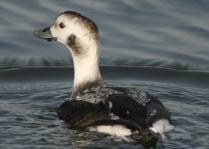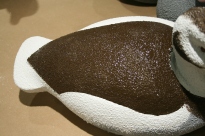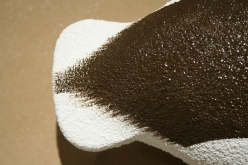A truly spectacular bird

I have not hunted a lot of Oldsquaw over the years. Nevertheless I always welcome the chance to see and hear these cold weather ducks. As with most ducks, my earliest memories are from the birds my Dad would bring home from Great South Bay in the 1950s. He did not pursue Oldsquaw in particular. Rather, they were an occasional bonus when he would be gunning Broadbill from his Great South Bay Ice Scooter. In his experience – and later my own – Oldsquaw would visit the rig when there was lots of ice around – and especially if one were rigged in an “airhole” in an otherwise frozen Bay.
The Oldsquaw below were a pleasant surprise. It is unusual to find this species anywhere near shore. These 2 birds were in a boat basin. I was able to photograph them from my car, parked so that the light was behind me and shining on them. One is an obvious adult Drake – but I believe the other is a young-of-the-year bird and not an adult Hen. The greyish back feathers – with little brown or reddish – tell me it is not a fully mature female.
Homer Oldsquaw
These decoys are from the Homer Decoy Company in Piqua, Ohio. A foam bird with a truly durable hard plastic head, these decoys are a nice complement to the old Herter’s Model 72 diver decoys that many of us grew up with – and still gun over. I just learned, though, that Homer is now offering a “magnum” Oldsquaw – built on the same body as their Eiders. Either way, my approach to painting them would be the same.

Preparation
As I do with most of my foam decoys, I put a tough skin on these Oldsquaw. These got my first experimentation with ground walnut shells (from Harbor Freight). I fastened the heads with stainless steel screw eyes – with the heads set in a paintable silicon caulk. Before doing so, I sanded each head with 100-grit and then wiped it with lacquer thinner.
I used the Fine grade particles and sprinkled them onto birds that had been painted with marine epoxy ( U S Composites 3:1, Medium Cure laminating epoxy) thickened with Cabosil.



After the epoxy cured, I coated them with an oil-based primer – and hung them up to dry.

Painting
As usual, my topcoats are latex paint. I use sample jars of Behr paints from Home Depot (although I buy full quarts of certain colors that I use on lots of different species).

I use a variety of brushes – the general rule being to use the largest brush you can for any painting task.

I used a pair of foamers – the first I ever carved – as the models for the paint.

And, I identified the 12 Drakes with pink bills and 6 Hens with blue-grey bills. I mixed a little WHITE into some OXBLOOD (Behr PPU 2-20) to make the pink – because I have the OXBLOOD on hand for Drake Mallards. You could get close with WHITE + MOROCCAN HENNA (Behr PPU 3-19). Similarly, instead of the DARK STORM CLOUDS (Behr 740-F4), you could just mix a little FLAT BLACK into some FLAT WHITE – to get a cool grey.

Painting the Drakes
Painting the Hens
Some finished birds


Sea Trials
Hope this is useful!
SJS































































